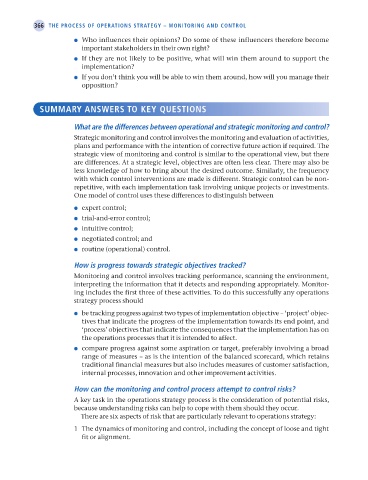Page 391 - Operations Strategy
P. 391
366 The proCess oF operaTIons sTraTegy – monITorIng and ConTrol
● Who influences their opinions? Do some of these influencers therefore become
important stakeholders in their own right?
● If they are not likely to be positive, what will win them around to support the
implementation?
● If you don’t think you will be able to win them around, how will you manage their
opposition?
summary ansWers To Key quesTIons
What are the differences between operational and strategic monitoring and control?
Strategic monitoring and control involves the monitoring and evaluation of activities,
plans and performance with the intention of corrective future action if required. The
strategic view of monitoring and control is similar to the operational view, but there
are differences. At a strategic level, objectives are often less clear. There may also be
less knowledge of how to bring about the desired outcome. Similarly, the frequency
with which control interventions are made is different. Strategic control can be non-
repetitive, with each implementation task involving unique projects or investments.
One model of control uses these differences to distinguish between
● expert control;
● trial-and-error control;
● intuitive control;
● negotiated control; and
● routine (operational) control.
how is progress towards strategic objectives tracked?
Monitoring and control involves tracking performance, scanning the environment,
interpreting the information that it detects and responding appropriately. Monitor-
ing includes the first three of these activities. To do this successfully any operations
strategy process should
● be tracking progress against two types of implementation objective – ‘project’ objec-
tives that indicate the progress of the implementation towards its end point, and
‘process’ objectives that indicate the consequences that the implementation has on
the operations processes that it is intended to affect.
● compare progress against some aspiration or target, preferably involving a broad
range of measures – as is the intention of the balanced scorecard, which retains
traditional financial measures but also includes measures of customer satisfaction,
internal processes, innovation and other improvement activities.
how can the monitoring and control process attempt to control risks?
A key task in the operations strategy process is the consideration of potential risks,
because understanding risks can help to cope with them should they occur.
There are six aspects of risk that are particularly relevant to operations strategy:
1 The dynamics of monitoring and control, including the concept of loose and tight
fit or alignment.
M10 Operations Strategy 62492.indd 366 02/03/2017 13:28

